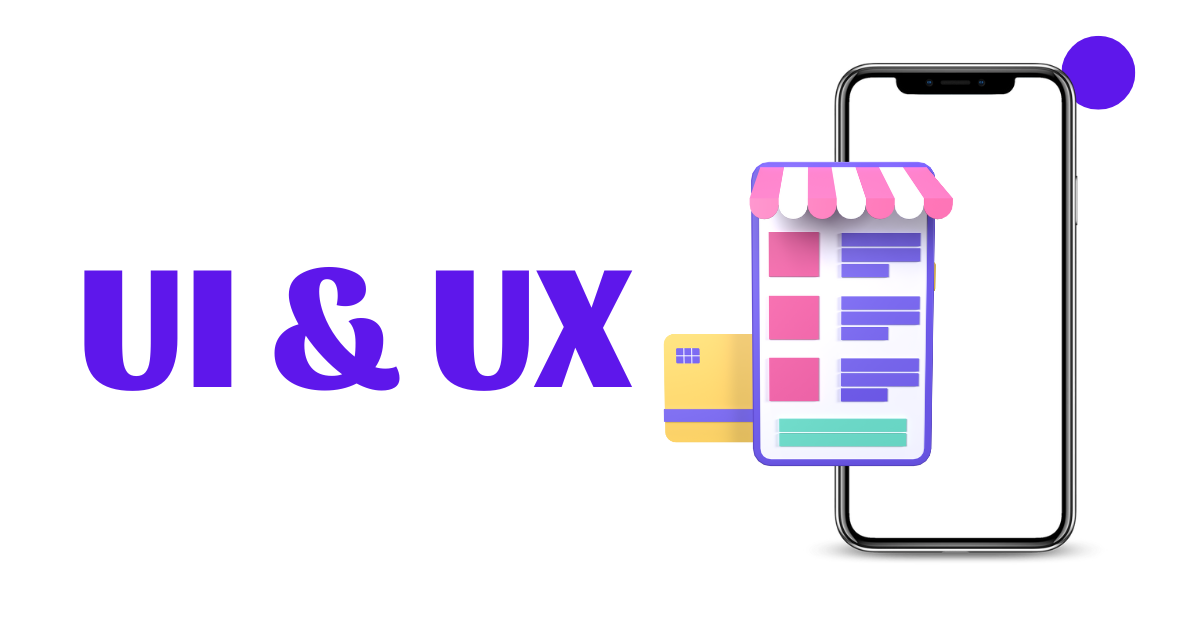The Difference between UI and UX Design
 Mansurul Haque
Mansurul Haque
UI and UX are two words you might hear together, but they don't mean the same thing.
UI design is about making things look good, while UX design is about making things work well.
Both are extremely important in the development of a digital product.
Companies can create more effective and user-friendly products that meet their customer's needs and expectations by understanding the unique roles and responsibilities of UI and UX designers.
In this blog, we'll explain what UI and UX mean and show you the differences between them.
Let’s get started!
What is UI design?
UI refers to the user interface. It is the point of interaction between the user and a device or digital product.
It’s the presentation of the visual elements that consumers use to interact with a product, system, or service.
UI design is all about how things look on websites, mobile apps, and other digital products. It includes screens, pages, buttons, and all other visual elements.
UI design also speaks about a brand. It instantly represents the company's tone, style, values, and more.
Good UI attracts consumers and creates emotional connections.
Design elements help users understand which buttons can be clicked, tapped, or swiped, which series of buttons are most important, and how to recognize call-to-action.
And UI designers think about how to design the buttons, shapes, icons, etc. and what color the elements should be, how they should be arranged on the page, and how they relate to each other.
UI designers visually represent the concepts and ideas that UX designers have pre-defined. They are responsible for ensuring appropriate contrast for both readability and usability. They have to design something that has a more consistent look and feel.
What is UX design?
UX refers to user experience. It's the relationship between a customer and a product or service. It is about how a user interacts with your product, how it solves their problem, and how it makes them feel.
Don Norman, a cognitive scientist who coined the term ‘UX’ says, “The user experience encompasses all aspects of the end user’s interaction with the company, its services, and products.”
UX design is the process of designing the whole experience for users when they use digital products, and services. The main purpose of UX design is to create a user experience easier, more comfortable, and more delightful.
It involves researching and improving all aspects of user interaction with a company's product.
UX designers are responsible for planning and organizing the product design process. They have a deep understanding of users and their needs.
UX designers decide how the user interface works and how buttons navigate users to complete tasks. They observe and perform analytics to see how users complete tasks.
UX designers continuously test their products and gather feedback to improve the user experience.
What are the differences between UI and UX design?
UI and UX sound very similar but there are huge differences.
Here are some of the key differences between UI and UX design:
Different Goals
The goal of UI design is to design attractive, visually appealing, predictable, understandable, and satisfying visual interfaces for users.
The goal of UX design is to design a seamless, intuitive, functional, accessible, and enjoyable experience for the users.
Different Focuses
UI design focuses on the visual representation of the look and feel of a product.
It deals with the aesthetics and presentation of the product including:
How will things look when users use them?
How to arrange and lay out design elements in an interface?
What colors and typography will perfectly match the product and represent the tone of the brand?
Which icons, illustrations, or images will attract users and tell the real story behind the concept?
How much space should there be between elements?
How much information should be on each screen?
Do the buttons' color and position encourage people to click or make them confused?
Does any text need to be bolded, highlighted, or in a different color?
UX design focuses on the user’s overall experience with a product or service.
It deals with the usability and functionality of the product including:
How to structure a product to solve the user’s problems?
What features would be in a product?
How do the features work?
How do users feel while using them?
Can users truly solve the problem with the product?
How a product can provide a good and smooth experience?
How the experience makes the user feel comfortable?
How will users spend more time on a product’s website?
What will happen when they visit a website or app?
Where to place design elements including navigation and CTA buttons to make it easy for users to click?
How easy it is for the user to achieve their goals through the product?
Different Skills
UI designer's skills include visual design, interaction design, creating mockups and prototypes, style guides, etc.
UX designers' skills include user research and analysis, creating user personas, user flow, prototypes, wireframes, user testing, usability testing, etc.
Different Output
The output of UI design is visual designs, mockups, style guides, etc.
The output of UX design is wireframes, prototypes, user flows, etc.
How do UI design and UX design work together?
UI without UX is like a car with no engine.
And UX without UI is like a blueprint without a building to bring it to life.
So they are closely related and essential for creating a successful product or service.
A website with a beautiful user interface but poor usability will frustrate users, and they will leave the site.
Similarly, A well-usable but not beautiful website cannot hold users' attention and engage them for long. Because people always want beauty and first impression matters.
So a product with a beautiful UI but poor UX will not meet the user's needs.
Also, a product with an excellent UX but an unattractive UI will not engage users.
Ultimately, UI and UX design are two sides of the same coin.
UI and UX designers work together to create a product that looks visually appealing while always being easy and enjoyable to use.
Building a product that meets the needs of users and satisfies them is the ultimate goal of UI and UX designers.
Importance of UI/UX Design
In today's digital world, UI/UX design is like a magic wand that can make or break a product. A well-designed UI/UX can make a product enjoyable, while a poorly designed one can be frustrating for users. That is why many UI/ UX designers and agencies constantly work to provide great digital products that add value to people’s lives.
Here are some key reasons why UI/UX design is important:
Captures user attention
A well-designed UI/UX of a product or service captures and holds user attention. This can create a visually appealing and user-friendly experience that is so enjoyable that users keep coming back for more.
Improves user engagement
Great UI/UX design helps users interact with a product easily and intuitively. It strongly engages users with a product.
Improves user satisfaction
A great UI/UX design makes it easy for users to find what they're looking for and complete tasks easily. This leads to positive reviews and user satisfaction.
Increases conversions
When users find a product looks beautiful, is easy to use, simple to complete tasks, that significantly improves user conversion rate.
Builds trust
When users have a positive experience using a product, users trust the brand and recommend it to others.
Increased brand recognition
A well-designed UI/UX increases brand recognition while a poorly designed UI/UX damages brand reputation.
Business growth
UI/UX design differentiates a product from its competitors. Creating a user-friendly and visually appealing interface increases revenue and profitability for businesses.
So UI/UX design has a significant impact on a business's growth and ROI (Return on Investment).
What does a UI designer do?
UI designers mainly design the look and feel of a product.
Let's take a closer look at the typical tasks of a UI designer.
User Research
UI designers work closely with UX designers to conduct user research and gather information and insights into user needs and problems.
Design research
UI designers are always up to date with design trends. They master design tools. They conduct design research to design visual elements in a way that attracts users and explains product concepts.
This information helps the designer to make data-driven design decisions that are based on user behavior.
Design principles
UI designers’ vision is on shapes, color combinations, and typography. They need to ensure that layouts are legible and presentable. So, they know design principles accurately and develop a strong visual eye for designing attractive and eye-catchy designs.
Visual Design
UI designers work on visual elements including shape, typography, color, images, illustrations, style, space between items, contrast, hierarchy, etc.
Interactive Design
They also create interactive elements of a product including buttons, icons, sliders, scrollbars, drop-down menus, etc.
Responsive design
They consider how a website or app will look on different devices and screen sizes.
Branding
UI designers create brand style guides and follow them while designing visual elements.
Prototyping
They create prototypes that allow them to quickly test multiple ideas before creating a final product and reduce the need for a written interpretation of a design.
What does a UX designer do?
UX designers work on designing the overall experience of users with a product or service. They are design thinking process experts. A UX designer knows how to research and analyze data, simplify, and implement.
Let’s see their tasks:
User Research
UX designers develop a clear understanding of their target users to identify what they need from the products they’re designing. They conduct user research to know who are the target customers, what are their needs, goals, requirements, problems, and pain points.
Creating personas
A user persona is a semi-fictional representation of the typical user of a product. UX designers create user personas to make a reliable and realistic representation of a typical user to identify their goals, desires, frustrations, etc. It is used to make in-depth scenarios. It shows how the product fits into the user's daily life.
Competitor Analysis
They conduct competitor analysis to know about the current market. It also helps to identify and evaluate the strengths and weaknesses of competitors' products or services.
By doing this, UX designers can create a user-friendly product that solves problems that their competitors haven't.
Information Architecture
In this phase, UX designers organize and structure the content and information presented in the final product or service. They do this in a way that helps users navigate and find what they need quickly and easily.
Wireframing
UX designers create wireframes. It is a rough skeleton that represents the various elements and user journeys when users interact with a website or app.
Prototyping
They create prototypes to demonstrate to stakeholders and gather user feedback.
User testing
UX designers conduct user testing to identify design problems before the team wastes time and effort developing the final product.
Final Words
It's important for anyone working on product design or development to know the differences between UI and UX.
Great design isn't just about how something looks, it's also about creating an experience that makes users happy.
So, keep in mind that your UI design should be visually appealing and your UX design should create a positive emotional connection with the user.
Best of Luck!
Subscribe to my newsletter
Read articles from Mansurul Haque directly inside your inbox. Subscribe to the newsletter, and don't miss out.
Written by

Mansurul Haque
Mansurul Haque
Founder & CEO at UIHUT